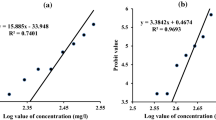Abstract
The effects of a paraquat commercial herbicide formulation on an early stage of the development ofPlecostomus commersoni were evaluated. Mortality, opercular ventilation rate, cardiac contraction rate and body length and weight were examined every 12 hr. The effects of the paraquat formulation on the morphology of the branchial epithelium were also examined by light microscopy. The assayed paraquat formulation significantly affected cardiac contraction and opercular ventilation. Ecotoxicologically, this could represent an important deleterious effect for early development of the catfish. Mortality data may not be sufficient for an appropriate evaluation of secondary environmental hazards associated with the application of paraquat formulation because: a) The LC-50 values forPlecostomus commersoni fry were higher than the recommended individual application rate of paraquat for aquatic weed control (0.1–2.0 mg/L). b) The estimated maximum acceptable toxicant concentration (MATC) resulted in a concentration similar to the application rate when calculated from acute toxicity tests. When the MATC was estimated from opercular ventilation or cardiac contraction rates, it was lower and fell within the recommended single application rate.
Similar content being viewed by others
References
Asztalos B, Nemcsók J (1985) Effect of pesticides on the LDH activity and isoenzyme pattern of carp (Cyprinus carpio L.) sera. Comp Biochem Physiol 82 C:217
Benoit DA, Puglisi FA, Olson DL (1982) A fathead minnow,Pimephales promelas, early life stage toxicity test method evaluation and exposure to four organic chemicals. Environ Pollut (Series A) 28:189
Calderbank A (1972) Environmental considerations in the development of diquat and paraquat as aquatic herbicides. Outl Agr 72:51
Call DJ, Poirier SH, Knuth ML, Karting SL, Lindberg CA (1987) Toxicity of 3,4-dichloroaniline to fathead minnows,Pimephales promelas, in acute and early life stage exposures. Bull Environ Contam Toxicol 38:352
Edwards CA (1977) Nature and origins of pollution of aquatic systems by pesticides. In: Pesticides in Aquatic Environments, Khan MAQ (ed); Plenum Press, New York
Finney DJ (1971) Probit Analysis. 3rd Ed; Cambridge Univ Press
Gabryelak T, Klekot J (1985) The effect of paraquat on the peroxide metabolism enzymes in erythrocytes of freshwater fish species. Comp Biochem Physiol 81C:415
Hashimoto Y, Okubo E, Ito T, Yamaguchi M, Tanaka S (1982) Changes in susceptibility of carp to several pesticides with growth. Pesticide Sci 7:457
Mallatt J (1985) Fish gill structure changes induced by toxicants and other irritants: a statistical review. Can J Fish Aquat Sci 42:630
Martoja R, Martoja Pierson M (1970) Técnicas de histología animal. Toray Mason Press, Barcelona
McKim JM (1977) Evaluation of tests with early life stages of fish for predicting long-term toxicity. J Fish Res Board Can 34:1148
Mount DI, Stephan CE (1967) A method for establishing acceptable toxicant limits for fish-Malathion and butoxyethanol ester of 2,4-D. Trans Am Fish Soc 96:185
Nemcsók J, Németh A, Buzás Z, Boross L (1984) Effects of copper, zinc, and paraquat on acetylcholinesterase activity in carp (Cyprinus carpio L.). Aquatic Toxicol 5:23
Newman JF (1970) Ecological implications of the use of paraquat and diquat as aquatic herbicides. Chem Ind 45:1424
Norberg TJ, Mount DI (1985) A new fathead minnow (Pimephales promelas) subchronic toxicity test. Environ Toxicol Chem 4:711
Steel RG, Torrie JH (1960) Principles and procedures of statistics with special references to biological sciences. McGraw Hill, New York
Temmink J, Bouwmeister P, de Jong P, van der Berg J (1983) An ultrastructural study of chromate-induced hyperplasia in the gill of rainbow trout (Salmo gairdneri). Aquatic Toxicol 4:165
Tortorelli MC, Hernández DA, Rey-Vázquez G, Salibián A (1987) Formulated paraquat-induced cardiorespiratory function damages in old-catfish fries. Abst 1st Congr Toxicol Developing Countries; Buenos Aires: 30
Van Leeuwen CJ, Griffioen PS, Vergouw WHA, Maas-Diepeveen JL (1985) Differences in susceptibility of early life stages of rainbow trout (Salmo gairdneri) to environmental pollutants. Aquatic Toxicol 7:59
Author information
Authors and Affiliations
Rights and permissions
About this article
Cite this article
Tortorelli, M.C., Hernández, D.A., Vázquez, G.R. et al. Effects of paraquat on mortality and cardiorespiratory function of catfish fryPlecostomus commersoni . Arch. Environ. Contam. Toxicol. 19, 523–529 (1990). https://doi.org/10.1007/BF01059071
Received:
Revised:
Issue Date:
DOI: https://doi.org/10.1007/BF01059071




